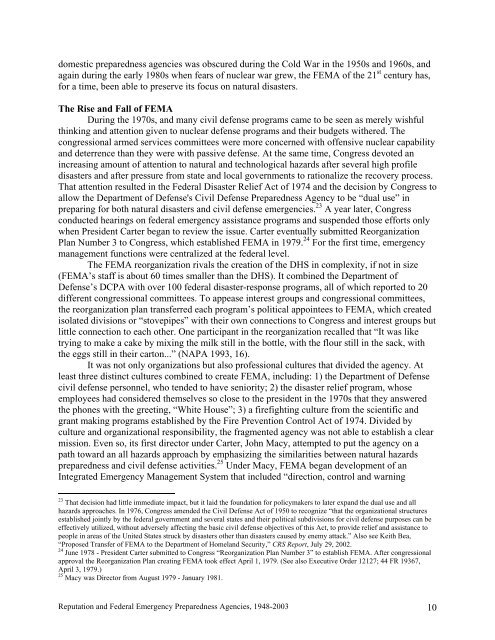Reputation and Federal Emergency Preparedness Agencies, 1948
Reputation and Federal Emergency Preparedness Agencies, 1948
Reputation and Federal Emergency Preparedness Agencies, 1948
You also want an ePaper? Increase the reach of your titles
YUMPU automatically turns print PDFs into web optimized ePapers that Google loves.
domestic preparedness agencies was obscured during the Cold War in the 1950s <strong>and</strong> 1960s, <strong>and</strong><br />
again during the early 1980s when fears of nuclear war grew, the FEMA of the 21 st century has,<br />
for a time, been able to preserve its focus on natural disasters.<br />
The Rise <strong>and</strong> Fall of FEMA<br />
During the 1970s, <strong>and</strong> many civil defense programs came to be seen as merely wishful<br />
thinking <strong>and</strong> attention given to nuclear defense programs <strong>and</strong> their budgets withered. The<br />
congressional armed services committees were more concerned with offensive nuclear capability<br />
<strong>and</strong> deterrence than they were with passive defense. At the same time, Congress devoted an<br />
increasing amount of attention to natural <strong>and</strong> technological hazards after several high profile<br />
disasters <strong>and</strong> after pressure from state <strong>and</strong> local governments to rationalize the recovery process.<br />
That attention resulted in the <strong>Federal</strong> Disaster Relief Act of 1974 <strong>and</strong> the decision by Congress to<br />
allow the Department of Defense's Civil Defense <strong>Preparedness</strong> Agency to be “dual use” in<br />
preparing for both natural disasters <strong>and</strong> civil defense emergencies. 23 A year later, Congress<br />
conducted hearings on federal emergency assistance programs <strong>and</strong> suspended those efforts only<br />
when President Carter began to review the issue. Carter eventually submitted Reorganization<br />
Plan Number 3 to Congress, which established FEMA in 1979. 24 For the first time, emergency<br />
management functions were centralized at the federal level.<br />
The FEMA reorganization rivals the creation of the DHS in complexity, if not in size<br />
(FEMA’s staff is about 60 times smaller than the DHS). It combined the Department of<br />
Defense’s DCPA with over 100 federal disaster-response programs, all of which reported to 20<br />
different congressional committees. To appease interest groups <strong>and</strong> congressional committees,<br />
the reorganization plan transferred each program’s political appointees to FEMA, which created<br />
isolated divisions or “stovepipes” with their own connections to Congress <strong>and</strong> interest groups but<br />
little connection to each other. One participant in the reorganization recalled that “It was like<br />
trying to make a cake by mixing the milk still in the bottle, with the flour still in the sack, with<br />
the eggs still in their carton...” (NAPA 1993, 16).<br />
It was not only organizations but also professional cultures that divided the agency. At<br />
least three distinct cultures combined to create FEMA, including: 1) the Department of Defense<br />
civil defense personnel, who tended to have seniority; 2) the disaster relief program, whose<br />
employees had considered themselves so close to the president in the 1970s that they answered<br />
the phones with the greeting, “White House”; 3) a firefighting culture from the scientific <strong>and</strong><br />
grant making programs established by the Fire Prevention Control Act of 1974. Divided by<br />
culture <strong>and</strong> organizational responsibility, the fragmented agency was not able to establish a clear<br />
mission. Even so, its first director under Carter, John Macy, attempted to put the agency on a<br />
path toward an all hazards approach by emphasizing the similarities between natural hazards<br />
preparedness <strong>and</strong> civil defense activities. 25 Under Macy, FEMA began development of an<br />
Integrated <strong>Emergency</strong> Management System that included “direction, control <strong>and</strong> warning<br />
23 That decision had little immediate impact, but it laid the foundation for policymakers to later exp<strong>and</strong> the dual use <strong>and</strong> all<br />
hazards approaches. In 1976, Congress amended the Civil Defense Act of 1950 to recognize “that the organizational structures<br />
established jointly by the federal government <strong>and</strong> several states <strong>and</strong> their political subdivisions for civil defense purposes can be<br />
effectively utilized, without adversely affecting the basic civil defense objectives of this Act, to provide relief <strong>and</strong> assistance to<br />
people in areas of the United States struck by disasters other than disasters caused by enemy attack.” Also see Keith Bea,<br />
“Proposed Transfer of FEMA to the Department of Homel<strong>and</strong> Security,” CRS Report, July 29, 2002.<br />
24 June 1978 - President Carter submitted to Congress “Reorganization Plan Number 3” to establish FEMA. After congressional<br />
approval the Reorganization Plan creating FEMA took effect April 1, 1979. (See also Executive Order 12127; 44 FR 19367,<br />
April 3, 1979.)<br />
25 Macy was Director from August 1979 - January 1981.<br />
<strong>Reputation</strong> <strong>and</strong> <strong>Federal</strong> <strong>Emergency</strong> <strong>Preparedness</strong> <strong>Agencies</strong>, <strong>1948</strong>-2003 10

















